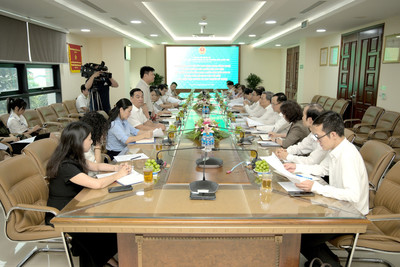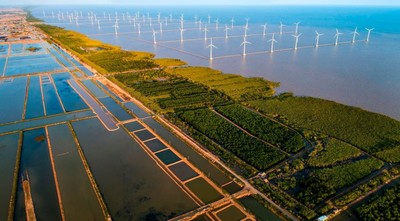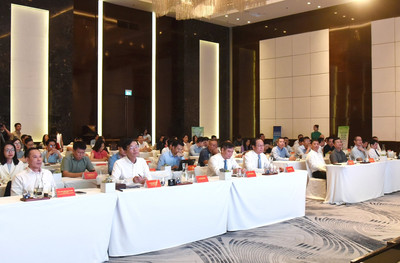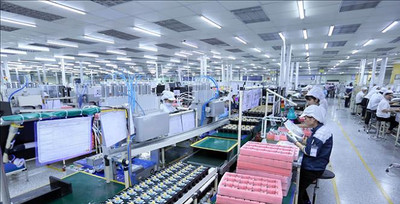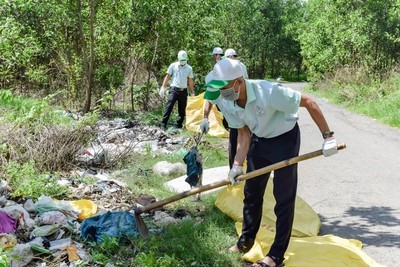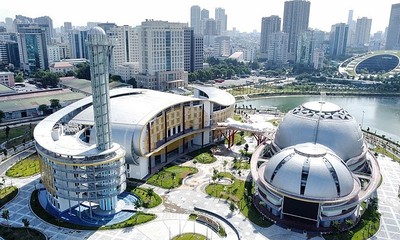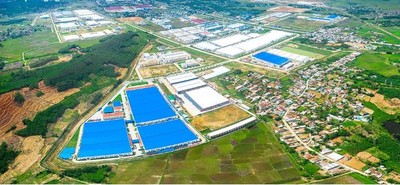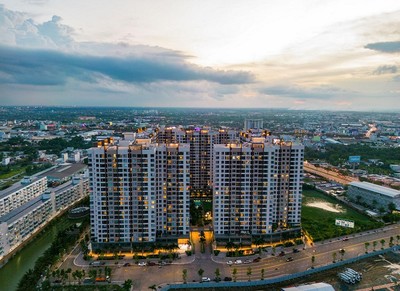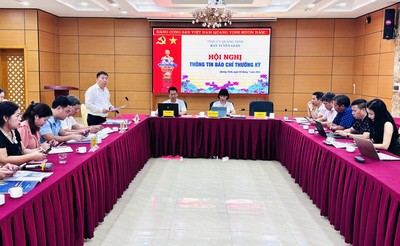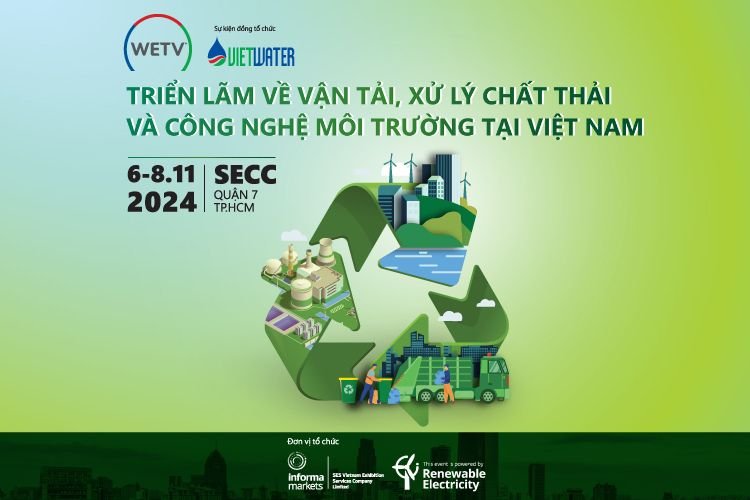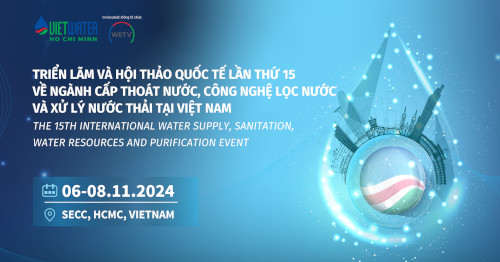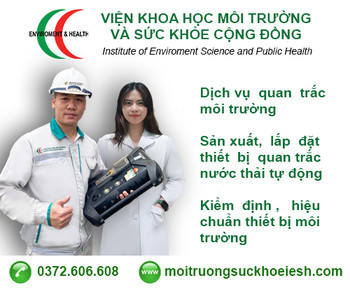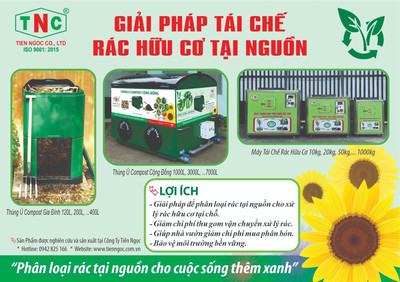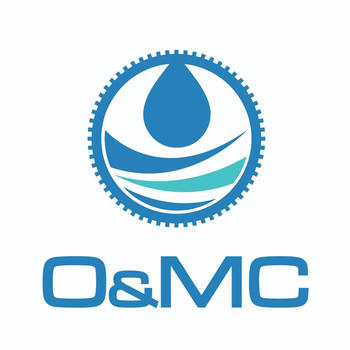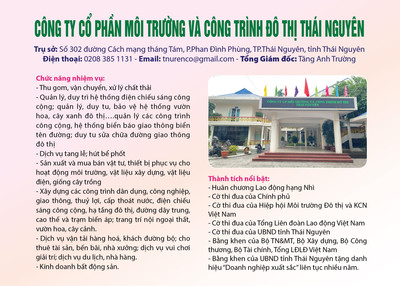Công bố quốc tế lĩnh vực môi trường số 24-2024
Ban biên tập Chuyên trang Quản lý Môi trường, Tạp chí Môi trường và Đô thị Việt Nam trân trọng giới thiệu tới quý độc giả Công bố quốc tế lĩnh vực môi trường số 24-2024.
Về quản lý môi trường
- Ước tính lưu trữ carbon và tối ưu hóa chiến lược theo mục tiêu carbon thấp cho không gian xanh gắn liền với đô thị.
- Dán nhãn và đánh giá hiệu suất năng lượng và tính bền vững trong khu vực dân dụng: Nghiên cứu điển hình về ESA-ESRIN ở Rome.
- Mối quan tâm của công chúng về môi trường, quy định về môi trường của chính phủ và giảm phát thải carbon đô thị - Phân tích vai trò điều tiết của tài chính xanh và tích tụ công nghiệp.
- Năng lượng tái tạo có chủ động góp phần giảm thiểu lượng khí thải carbon ở các quốc gia tiêu thụ nhiên liệu hóa thạch lớn không?
- Định hình một ngày mai xanh hơn: Phân tích tác động của công nghệ thân thiện với môi trường đến dấu chân sinh thái ở các nền kinh tế mới nổi ở Châu Á.
- Giám sát nước thải và nước biển ở Nam Cực: Lấy mẫu thụ động như một chiến lược mạnh mẽ để đánh giá tình trạng ô nhiễm mới nổi.
- Tác động đơn lẻ và hỗn hợp của việc phơi nhiễm nhiều hợp chất hữu cơ dễ bay hơi lên các thông số huyết học ở dân số trưởng thành ở Hoa Kỳ.
- Các chất gây ô nhiễm môi trường và exosome: Một mô hình mới về sức khỏe và bệnh tật môi trường.
- Đánh giá hiện trạng nghiên cứu ô nhiễm nhựa ở Nam Cực: Khoảng trống kiến thức và khuyến nghị.
- Lấy mẫu, thành phần và tác động sinh học của vật chất hạt trong không khí ở Thành phố Mexico từ nhiều thời kỳ.
- Tác động của COVID-19 đối với môi trường biển và ven biển: Ô nhiễm vi nhựa trầm trọng hơn, chất lượng không khí được cải thiện và viễn cảnh tương lai.
- Khám phá phơi nhiễm dân cư: Xác định chất chống cháy nguy hiểm trong bụi lọc không khí từ hệ thống HVAC.
Về môi trường đô thị
- Đánh giá định lượng mức độ tiếp xúc với cây xanh đô thị và tác động của nó đối với sức khỏe con người: Một nghiên cứu điển hình về quy tắc không gian xanh 3-30-300.
- Tiềm năng thu hồi nước từ nước thải đô thị - Góc nhìn của người vận hành nhà máy xử lý nước thải đô thị ở Ba Lan.
- Ô nhiễm hệ sinh thái dưới nước bởi các chất ô nhiễm hữu cơ khó phân hủy (POP) có nguồn gốc từ các bãi chôn lấp ở Canada và Hoa Kỳ: Đánh giá phạm vi nhanh.
- Rừng là rào cản siêu vật liệu tự nhiên để giảm rung động do đường sắt đô thị gây ra.
- Ứng dụng ozon hóa xúc tác sử dụng zeolite Y trong việc loại bỏ dược phẩm trong nước thải từ các nhà máy xử lý nước thải đô thị.
- Khám phá các chiến lược lấy phương tiện làm trung tâm để di chuyển bền vững trong đô thị: Khung lý thuyết về tiết kiệm năng lượng và giảm tiếng ồn trong giao thông.
- Việc tiếp xúc với các hạt vật chất trong đô thị làm thay đổi phản ứng của tế bào niêm mạc khứu giác đối với nhiễm trùng SARS-CoV-2.
- Đánh giá vai trò của dòng lạnh và mô hình khái quát đối với ô nhiễm không khí ở Bán đảo Triều Tiên.
- Sự thích nghi về vật liệu làm tổ của các loài chim bản địa với rác thải do con người tạo ra dọc theo độ dốc đô thị hóa ở Pakistan.
- Mối quan hệ giữa chất lượng nước với virut và điện trở của vi sinh vật trong dòng suối đô thị ở Brazil.
- Ra mắt động lực học khí dung ở chế độ thô và mịn trên đất toàn cầu từ năm 2005 đến năm 2020 bằng cách sử dụng dữ liệu đảo ngược hàng tháng dựa trên vệ tinh nâng cao.
Về môi trường khu công nghiệp
- Sự biến đổi không gian, nguồn và khả năng biến đổi khí quyển của các hợp chất hữu cơ dễ bay hơi trong khu công nghiệp dựa trên các phép đo có độ phân giải cao ở ba nhà máy.
- Tác động của các sáng kiến quản lý carbon đối với hiệu quả ESG của doanh nghiệp trong lĩnh vực bất động sản: Bằng chứng quốc tế.
- Đánh giá rủi ro sinh thái của các yếu tố tiềm tàng độc hại (PTE) trong đất nông nghiệp, rau và trái cây theo độ dốc khoảng cách gần với ngành công nghiệp pin axit chì.
- Tiết lộ sức mạnh của giá trị xã hội: Xúc tác nền kinh tế tuần hoàn ở các doanh nghiệp vừa và nhỏ ở thị trường mới nổi.
- Xử lý sinh học nano: Một cách tiếp cận tiềm năng để khử nhiễm môi trường tập trung vào đất, nước và kim loại nặng.
- Việc chuyển đổi sang nền kinh tế tuần hoàn có góp phần tăng cường khả năng phục hồi và chuyển đổi của doanh nghiệp không? Bằng chứng từ các doanh nghiệp vừa và nhỏ.
- Những tiến bộ gần đây trong xử lý nước thải mỏ axit thông qua công nghệ lai: Đánh giá toàn diện các tài liệu khoa học.
- Loại bỏ kim loại nặng bằng vật liệu gốc xenlulo: Đánh giá nhỏ.
- Tái chế phế thải công nghiệp đa nguồn làm chất kết dính xanh cho bãi lấp chất thải siêu mịn xi măng: Động học hydrat hóa, tính chất cơ học và cơ chế hóa rắn.
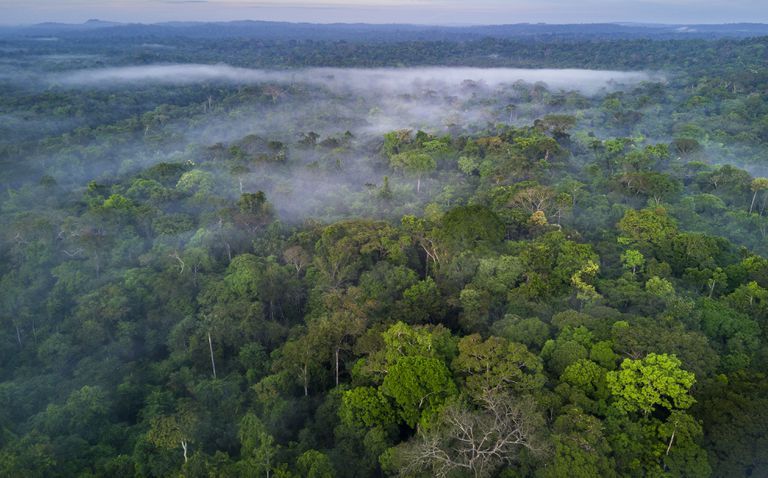
CHUYÊN TRANG QUẢN LÝ MÔI TRƯỜNG
Tạp chí Môi trường và Đô thị Việt Nam
Xin trân trọng giới thiệu!
The Environmental Management Special Section is pleased to present to our valued readers the International Environmental Bulletin No 24/2024, featuring the following key topics:
ENVIRONMENTAL MANAGEMENT / QUẢN LÝ MÔI TRƯỜNG
1. Carbon storage estimation and strategy optimization under low carbon objectives for urban attached green spaces
Science of The Total Environment, Volume 923, 1 May 2024, 171507
Abstract
In the context of rapid urbanization, scarce land resources have highlighted the importance of attached green spaces (AGS), which have received limited attention despite their critical importance in the urban carbon cycle. Analyzing the differences in carbon storage of different AGS types and proposing different optimization strategies can provide a reference for urban managers to scientifically enhance the carbon sinks of greenfield. This study estimated the carbon storage of AGS in central Shanghai using a series of detailed field survey data and remote sensing data.
The results showed that AGS stored 296 Gg (1Gg = 109 g) of carbon, accounting for 56 % of the total carbon storage in all urban green spaces. While carbon density in AGS is lower than that in other green space types due to the dominance of small trees, simple vegetation structures and poor maintenance in some areas. Significant differences in carbon storage capacity were also found among different types of AGS, related to individual vegetation attributes and vegetation structure. Our findings emphasized that optimal design strategies should be different for various green space types, and proposed corresponding optimization strategies for different AGS types. Furthermore, the dual role of multi-layered planting structures in carbon sinks and biodiversity was also emphasized.
2. Labeling and assessment of energy and sustainability performances in the civil sector: The case study of ESA-ESRIN in Rome
Journal of Cleaner Production, Volume 453, 10 May 2024, 142135
Abstract
The continuous improvement of the energy and sustainability performances of buildings is stimulated by mandatory rules, economic incentives and voluntary sustainability pathway of which energy efficiency is one of the most important components. The tools to evaluate the energy, sustainability, automation and energy metering performances of buildings, to check the status and lead the investments, are often complex, slow, expensive and related to the specific Countries, making difficult the job for the facility management departments of national or international organizations in EU.
The present paper wants to give a contribute to existing literature by providing a new energy, sustainability, automation and energy metering label system to quickly, simply and economically evaluate the performances of office buildings in Europe. This tool has been tested on a case study, a research center of the European Space Agency (ESA-ESRIN) in Rome, Italy.
The results of the test show that the tool has been successfully applied on the buildings of the research center using the data provided by the facility management department of ESA-ESRIN and the energy audit of the center. The labels can correctly represent the state of the buildings in a more cost-effective way if compared to the national energy certification and to international sustainability protocols.
This study provides the facility management departments of public and private companies in EU - especially if they manage buildings in different EU nations - a reliable tool to quicky evaluate the energy, sustainability, automation and energy metering performances of their buildings.
3. Association between ambient temperature and mammalian-related injuries in Guangzhou, China, 2014-2019
Science of The Total Environment, Volume 923, 1 May 2024, 171415
Abstract
Background
Meteorological factors are associated with various health outcomes. However, it remains uncertain whether ambient temperature affects animal aggressive behaviors and causes mammalian-related injuries (MRI) in humans. The study aimed to examine the effect of daily mean temperature on MRI in Guangzhou, China.
Methods
Individual cases of MRI were obtained from Guangzhou Injury Surveillance System during 2014–2019. A combination of a distributed lag nonlinear model and conditional quasi-Poisson regression, implemented within a time-stratified case-crossover design, was employed to evaluate the association between temperature and MRI. Subgroup analyses were conducted by sex, age group, education level, and types of mammals.
Result
This study included 24,206 MRI cases among which 89.7 % were caused by cats or dogs. We observed a nonlinear relationship between daily mean temperature and MRI. The impact of high temperatures was most pronounced on the current day and remained statistically significant on the next day. Compared with the reference temperature with a minimum risk of injuries (9.3 °C, approximately 2nd percentile of temperature), 75th percentile of temperature (27.4 °C) exerted the greatest relative risk (RR) of injuries (RR = 1.45, 95 % CI: 1.25–1.68) over lag 0–1 days. In subgroup analyses, the effects of high temperatures among males and females were similar. Individuals aged 15–34 years and 35–59 years were more susceptible to MRI at high temperatures compared to other age groups. The risk of injuries caused by cats or dogs consistently increased with high temperatures. We did not find significant impacts of low temperatures.
Conclusion
Short-term heat exposure plays an important role in the occurrence of MRI. The findings highlight the importance of enhancing public awareness regarding the high temperature-associated hazards posed by mammals. There is a need for enhanced regulations and measures on the management for cats and dogs to mitigate the harm caused in hot seasons.
4. Insight into the imbalance of forest cover change at county level in mainland China during 2000-2020: From the perspective of subdividing forest cover change into forest gain and loss
Journal of Cleaner Production, Volume 453, 10 May 2024, 142238
Abstract
The significant growth of China's forest resources presents a remarkable case in global vegetation dynamics. However, there is spatial imbalance in forest cover changes, which is not only reflected in regional imbalances, but also between total and net changes. There is still a lack of knowledge in this imbalance. In our comprehensive study, we subdivided forest cover change into forest gain and loss, and calculated the total and net forest change across 2850 county-level administrative units in mainland China, utilizing the Global Forest Change Dataset.
The univariate linear regression and the Sen + Mann-Kendall test is utilized to explore the temporal trends in forest loss. Additionally, spatial autocorrelation models were employed to examine the spatial differentiation of forest cover change. Our findings unveiled a wide spectrum of forest loss rates ranging from 0% to 27%, and gain rates ranging from 0% to 10%, with the highest rates observed in the southern counties. We observed that the forest loss trends in southeastern counties showed significant and slight increases, while the northwestern counties experienced significant and slight decreases, with the Huhuanyong Line serving as the demarcation.
In terms of spatial patterning, quite a number of the southern counties displayed a "large net change, large total change” state, which contrasted with diverse patterns observed in certain western regions. Spatial autocorrelation analysis showed that the High-high clusters of both forest gain and loss were primarily observed in southern counties, with the Low-low clusters in the northwest. This detailed analysis provides valuable insights into the dynamics of forest cover changes, offering a robust scientific foundation for developing informed and region-specific conservation policies.
5. Public environmental concern, government environmental regulation and urban carbon emission reduction - Analyzing the regulating role of green finance and industrial agglomeration
Science of The Total Environment, Volume 924, 10 May 2024, 171549
Abstract
In the multifaceted realm of environmental governance, emphasizing public environmental participation as an informal regulatory mechanism, alongside the influence of formal governmental environmental regulation on regional carbon emissions, contributes to providing empirical evidence and policy insights for China's "dual‑carbon target” action plan. Using data from 282 prefecture-level cities in China from 2011 to 2020, this research develops an analytical framework for urban carbon emissions encompassing public environmental concern, environmental regulation, green finance, and industrial agglomeration. And through an amalgamation of theoretical insights and empirical validation, the study elucidates the mechanisms by which public environmental concern impact urban carbon emissions. It further delves into the mediating role of environmental regulation and the moderating effects of green finance and industrial agglomeration.
It reveals that: (1) Public environmental concern significantly reduces urban carbon emissions, particularly in northern cities, non-environmental protection key cities, and resource regeneration cities. And this suppressive influence is markedly more potent via mobile platforms compared to PC channels; (2) Environmental regulation serves as a partially mediating role between public environmental concern and urban carbon emissions, suggesting that public environmental concern reduces emissions by amplifying governmental environmental oversight; (3) Both green finance and industrial agglomeration play a positive moderating role on the effect of public environmental concern in reducing urban carbon emissions.
6. Does renewable energy proactively contribute to mitigating carbon emissions in major fossil fuels consuming countries?
Journal of Cleaner Production, Volume 452, 1 May 2024, 142113
Abstract
The success of global climate initiatives (SDG-13, COP28) heavily depends on the actions of major fossil fuels consuming countries, as their continued reliance on these energy sources greatly impedes progress towards global climate objectives. Transitioning from the dominance of fossil fuels to the expansion of renewable energy is crucial for ensuring Sustainable Development Goals (SDGs) and Conference on Parties (COP) objectives under UN climate change initiatives, as well as for achieving environmental sustainability. This study investigates the proactive role of renewable energy in enhancing environmental sustainability and evaluates the impact of fossil fuel consumption, real gross domestic product ), square of , and patents on carbon emissions in major fossil fuels consuming countries from 1990 to 2020 after considering and disregarding the EKC model. Two-way additive and interactive fixed effect models demonstrate a statistically significant negative effect of renewable energy on carbon emissions. A method of moments quantile regression endorses the asymmetric negative effects of renewable energy across different quantiles of CO2 emissions. According to the quantile regression, a low CO2 emitting country's environmental quality is largely sensitive to the consumption of renewable energy. Also, after considering heterogeneity, cross-sectional dependence and endogeneity issues, the effect of renewable energy remains unchanged. On the contrary, unlike renewable energy, fossil fuel consumption, real GDP, square of real GDP, and patents have positive effects in most cases, worsening environmental quality by increasing CO2 levels. Therefore, based on these findings, our study emphasizes pivotal policy implications aimed at fostering a better environment in major fossil fuels consuming countries.
7. Characterization and childhood exposure assessment of toxic heavy metals in household dust under true living conditions from 10 China cities
Science of The Total Environment, Volume 925, 15 May 2024, 171669
Abstract
Health hazards caused by metal exposure in household dust are concerning environmental health problems. Exposure to toxic metals in household dust imposes unclear but solid health risks, especially for children. In this multicenter cross-sectional study, a total of 250 household dust samples were collected from ten stratified cities in China (Panjin, Shijiazhuang, Qingdao, Lanzhou, Luoyang, Ningbo, Xi'an, Wuxi, Mianyang, Shenzhen) between April 2018 and March 2019. Questionnaire was conducted to gather information on individuals' living environment and health status in real-life situations. Multivariate logistic regression and principal component analysis were conducted to identify risk factors and determine the sources of metals in household dust. The median concentration of five metals in household dust from 10 cities ranged from 0.03 to 73.18 μg/g. Among the five heavy metals, only chromium in household dust of Mianyang was observed significantly both higher in the cold season and from the downwind households.
Mercury, cadmium, and chromium were higher in the third-tier cities, with levels of 0.08, 0.30 and 97.28 μg/g, respectively. There were two sources with a contribution rate of 38.3 % and 25.8 %, respectively. Potential risk factors for increased metal concentration include long residence time, close to the motorway, decoration within five years, and purchase of new furniture within one year. Under both moderate and high exposure scenarios, chromium showed the highest level of exposure with 6.77 × 10−4 and 2.28 × 10−3 mg·kg−1·d−1, and arsenic imposed the highest lifetime carcinogenic risk at 1.67 × 10−4 and 3.17 × 10−4, respectively. The finding highlighted the priority to minimize childhood exposure of arsenic from household dust.
8. Shaping a greener tomorrow: Analysing the impact of environment-friendly technology on ecological footprints in emerging asian economies
Journal of Cleaner Production, Volume 452, 1 May 2024, 142130
Abstract
The impact of environment-friendly technology on environment quality is an unsettled debate having generated more heat than light. Given this context, the study explores the impact of environment-friendly on ecological footprints using the Environmental Kuznets Curve framework. Utilizing Panel Autoregressive Distributive Lag model for aggregate ecological footprint doesn't show the evidence of environment-friendly technology improving environmental quality.
However, disaggregated analysis reveals significant reductions in footprints related to Built-up, Crop, Fishing Grounds, and Grazing lands, with positive impacts observed on Forest and Carbon footprints. We also estimate the turning points of per capita income, confirming heterogeneous and footprint-specific Kuznets curves. Notably, we show that environment-friendly technology plays a crucial role in delaying depletion in Built-up land and contracting the depletion phase of Fishing Grounds along the Kuznets curve trajectory. The study, therefore, underscores the importance of environment-friendly technology in addressing environmental challenges and promoting environmental sustainability.
9. Wastewater and seawater monitoring in Antarctica: Passive sampling as a powerful strategy to evaluate emerging pollution
Science of The Total Environment, Volume 925, 15 May 2024, 171755
Abstract
The Ross Sea, among the least human-impacted marine environments worldwide, recently became the first marine protected area in Antarctica.
To assess the impact of the Italian research station Mario Zucchelli (MZS) on the surrounding waters, passive sampling – as well as spot sampling for comparison – took place in the effluent of the wastewater treatment plant (WWTP) and the receiving surface marine waters. Polar Organic Chemical Integrative Samplers (POCIS) were deployed for six consecutive 2-week periods from November to February in a reservoir collecting the wastewater effluent. Passive samplers were also deployed at shallow depth offshore from the wastewater effluent outlet from MZS for two separate 3-week periods (November 2021 and January 2022). Grab water samples were collected alongside each POCIS deployment, for comparison with passive sampling results.
POCIS, used for the first time in Antarctica, demonstrated to be advantageous to estimate time-averaged concentrations in waters and the results were comparable to those obtained by repeated spot samplings. Among the 23 studied ECs – including drugs, UV-filters, perfluorinated substances, caffeine – 15 were detected in both grab and passive sampling in the WWTP effluent and followed similar concentration profiles in both types of sampling. High concentrations of caffeine, naproxen and ketoprofen in the dozens of μg L−1 were detected. Other compounds, including drugs and several UV filters, were detected down to sub- μg L−1 concentrations. In marine waters close to the effluent output, only traces of a drug (4.8 ng L−1) and two UV filters (up to 0.04 μg L−1) were quantified.
10. Single and mixed effects of multiple volatile organic compounds exposure on hematological parameters in the U.S. adult population
Chemosphere, Volume 355, May 2024, 141825
Abstract
Background
Most research exploring the correlation between volatile organic compounds (VOCs) and hematological parameters have focused on single VOCs. Our study aimed to explore the single and combined effects of VOCs on hematological parameters through three statistical models.
Methods
Data from 4 cycles of the National Health and Nutrition Examination Survey (NHANES) were used in this study. The correlations between single exposure to 16 VOCs and hematological parameters in the general population were assessed by weighted multiple linear regression. Weighted quantile sum (WQS) and Bayesian kernel machine regression (BKMR) models were used to explore the relationship between the combined important VOCs selected by the least absolute shrinkage and selection operator (LASSO) and hematological parameters, as well as the effects of smoking status on them.
Results
A total of 4089 adults were included in the study. We found that a variety of VOCs were significantly associated with hematological parameters. Among them, N-acetyl-S-(benzyl)-l-cysteine (BMA) was significantly negatively correlated with white blood cell (WBC), red blood cell (RBC), lymphocyte, and neutrophil counts. N-acetyl-S-(3-hydroxypropyl-1-methyl)-l-cysteine (HPMMA) was significantly positively correlated with WBC, monocyte, lymphocyte, and neutrophil counts. In the WQS analysis, the WQS index of the VOCs mixtures was positively correlated with WBC (β: 0.031; P < 0.001), monocyte (0.023; P = 0.021), and neutrophil (0.040; P = 0.001) counts, while negatively associated with RBC (−0.013; P < 0.001) counts. The BKMR model revealed that combined exposure to VOCs levels ≥70th percentile was significantly associated with lower RBC counts, and BMA was identified as the dominant contributor. Smoking significantly influenced the relationship between VOCs and hematological parameters.
Conclusions
Our study indicated the effects of single and overall VOCs exposure on hematological parameters and suggested the hematotoxicity as well as pro-inflammatory effects of VOCs, which had strong public health implications for reducing the potential health hazards of VOCs exposure to the hematologic system.
11. Environmental pollutants and exosomes: A new paradigm in environmental health and disease
Science of The Total Environment, Volume 925, 15 May 2024, 171774
Abstract
This study investigates the intricate interplay between environmental pollutants and exosomes, shedding light on a novel paradigm in environmental health and disease. Cellular stress, induced by environmental toxicants or disease, significantly impacts the production and composition of exosomes, crucial mediators of intercellular communication. The heat shock response (HSR) and unfolded protein response (UPR) pathways, activated during cellular stress, profoundly influence exosome generation, cargo sorting, and function, shaping intercellular communication and stress responses. Environmental pollutants, particularly lipophilic ones, directly interact with exosome lipid bilayers, potentially affecting membrane stability, release, and cellular uptake.
The study reveals that exposure to environmental contaminants induces significant changes in exosomal proteins, miRNAs, and lipids, impacting cellular function and health. Understanding the impact of environmental pollutants on exosomal cargo holds promise for biomarkers of exposure, enabling non-invasive sample collection and real-time insights into ongoing cellular responses. This research explores the potential of exosomal biomarkers for early detection of health effects, assessing treatment efficacy, and population-wide screening. Overcoming challenges requires advanced isolation techniques, standardized protocols, and machine learning for data analysis. Integration with omics technologies enhances comprehensive molecular analysis, offering a holistic understanding of the complex regulatory network influenced by environmental pollutants. The study underscores the capability of exosomes in circulation as promising biomarkers for assessing environmental exposure and systemic health effects, contributing to advancements in environmental health research and disease prevention.
12. Assessing the current state of plastic pollution research in Antarctica: Knowledge gaps and recommendations
Chemosphere, Volume 355, May 2024, 141870
Abstract
Antarctica stands as one of the most isolated and pristine regions on our planet. Regardless, recent studies have evidenced the presence of plastic pollution in Antarctic environments and biota. While these findings are alarming and put into perspective the reach of plastic pollution, it is necessary to assess the current knowledge of plastic pollution in Antarctica. In the present review, an updated literature review of plastic pollution in multiple Antarctic environmental compartments and biota was conducted. Studies were cataloged based on environmental compartments (e.g., sediments, seawater, soil, atmosphere) and biota from different ecological niches. A detailed analysis of the main findings, as well as the flaws and shortcomings across studies, was conducted. In general terms, several studies have shown a lack of adequate sampling and analytical procedures for plastic research (particularly in the case of microplastics) and standard procedures; thus, compromising the reliability of the data reported and comparability across studies. Aiming to guide future studies and highlight research needs, a list of knowledge gaps and recommendations were provided based on the analysis and discussion of the literature and following standardized procedures.
13. Sampling, composition, and biological effects of Mexico City airborne particulate matter from multiple periods
Science of The Total Environment, Volume 926, 20 May 2024, 171933
Abstract
Air pollution is a worldwide environmental problem with an impact on human health. Particulate matter of ten micrometers or less aerodynamic diameter (PM10) as well as its fine fraction (PM2.5) is related to multiple pulmonary diseases. The impact of air pollution in Mexico City, and importantly, particulate matter has been studied and considered as a risk factor for two decades ago. Previous studies have reported the composition of Mexico City particulate matter, as well as the biological effects induced by this material. However, material collected and used in previous studies is a limited resource, and sampling and particle recovery techniques have been improved. In this study, we describe the methods used in our laboratory for Mexico City airborne particulate matter PM10 and PM2.5 sampling, considering the years 2017, 2018 and 2019.
We also analyzed the PM10 and PM2.5 samples obtained to determine their composition. Finally, we exposed lung cell line cultures to PM10 and PM2.5 to evaluate the biological effect of the material in terms of cell viability, cell death, inflammatory response, and cytogenetic alterations. Our results showed that PM10 composition includes inorganic, organic and biological compounds, while PM2.5 is a mixture of more enriched organic compounds. PM10 and PM2.5 treatment in lung cells does not significantly impact cell viability/cell death. However, PM10 and PM2.5 increase the secretion levels of IL-6. Moreover, PM10 as well as PM2.5 induce cytogenetic alterations, such as micronuclei, anaphase bridges, trinucleated cells and apoptotic cells in lung cells. Our results update the evidence of the composition and biological effects of Mexico City particulate matter and provide us a reliable basis for future approaches.
14. Effects of COVID-19 on coastal and marine environments: Aggravated microplastic pollution, improved air quality, and future perspective
Chemosphere, Volume 355, May 2024, 141900
Abstract
The COVID-19 pandemic during 2020–2023 has wrought adverse impacts on coastal and marine environments. This study conducts a comprehensive review of the collateral effects of COVID-19 on these ecosystems through literature review and bibliometric analysis. According to the output and citation analysis of these publications, researchers from the coastal countries in Asia, Europe, and America payed more attentions to this environmental issue than other continents. Specifically, India, China, and USA were the top three countries in the publications, with the proportion of 19.55%, 18.99%, and 12.01%, respectively. The COVID-19 pandemic significantly aggravated the plastic and microplastic pollution in coastal and marine environments by explosive production and unproper management of personal protective equipment (PPE).
During the pandemic, the estimated mismanaged PPE waste ranged from 16.50 t/yr in Sweden to 250,371.39 t/yr in Indonesia. In addition, the PPE density ranged from 1.13 × 10−5 item/m2 to 2.79 item/m2 in the coastal regions worldwide, showing significant geographical variations. Besides, the emerging contaminants released from PPE into the coastal and marine environments cannot be neglected. The positive influence was that the COVID-19 lockdown worldwide reduced the release of air pollutants (e.g., fine particulate matter, NO2, CO, and SO2) and improved the air quality. The study also analyzed the relationships between sustainable development goals (SDGs) and the publications and revealed the dynamic changes of SDGs in different periods the COVID-19 pandemic. In conclusion, the air was cleaner due to the lockdown, but the coastal and marine contamination of plastic, microplastic, and emerging contaminants got worse during the COVID-19 pandemic. Last but not least, the study proposed four strategies to deal with the coastal and marine pollution caused by COVID-19, which were regular marine monitoring, performance of risk assessment, effective regulation of plastic wastes, and close international cooperation.
15. Use of micropollutant indicator ratios to characterize wastewater treatment plant efficiency and to identify wastewater impact on groundwater
Journal of Environmental Management, Volume 358, May 2024, 120822
Abstract
Contamination by wastewater has been traditionally assessed by measuring faecal coliforms, such as E. coli and entereococci. However, using micropollutants to track wastewater input is gaining interest. In this study, we identified nine micropollutant indicators that could be used to characterize water quality and wastewater treatment efficiency in pond-based wastewater treatment plants (WWTPs) of varying configuration. Of 232 micropollutants tested, nine micropollutants were detected in treated wastewater at concentrations and frequencies suitable to be considered as indicators for treated wastewater.
The nine indicators were then classified as stable (carbamazepine, sucralose, benzotriazole, 4+5-methylbenzotriazole), labile (atorvastatin, naproxen, galaxolide) or intermediate/uncertain (gemfibrozil, tris(chloropropyl)phosphate isomers) based on observed removals in the pond-based WWTPs and correlations between micropollutant and dissolved organic carbon removal. The utility of the selected indicators was evaluated by assessing the wastewater quality in different stages of wastewater treatment in three pond-based WWTPs, as well as selected groundwater bores near one WWTP, where treated wastewater was used to irrigate a nearby golf course. Ratios of labile to stable indicators provided insight into the treatment efficiency of different facultative and maturation ponds and highlighted the seasonal variability in treatment efficiency for some pond-based WWTPs. Additionally, indicator ratios of labile to stable indicators identified potential unintended release of untreated wastewater to groundwater, even with the presence of micropollutants in other groundwater bores related to approved reuse of treated wastewater.
16. Exploring the residential exposome: Determination of hazardous flame retardants in air filter dust from HVAC systems
Environmental Research, Volume 248, 1 May 2024, 118223
Abstract
Dust is a sink for flame retardants, which are added to a myriad of consumer products in residential spaces. Organophosphate esters (OPEs) and brominated flame retardants (BFRs) are two classes of flame retardants that are frequently used in consumer products and consequently found in dust. In this present work, a novel solvent-limited microextraction technique, which we detailed in a companion study, was applied for the determination of four OPEs and two BFRs with limits of quantitation at the ng/g level by gas chromatography-mass spectrometry and liquid chromatography-mass spectrometry from n = 47 air filter dust samples collected from forced air HVAC systems.
Levels of the BFRs, including tetrabromobisphenol-A and its derivative tribromobisphenol-A, were found at levels <4 μg/g and not frequently detected. Conversely, all four OPEs were detected in all air filter dust samples. Total OPE load was dominated by tris(2,4-di-tert-butylphenyl) phosphate, T24DtBPP, a novel OPE not widely examined in the literature. Comparison of individual and total OPE concentrations to residential characteristics revealed statistically significant relationships to location of the home and dominant flooring type. Overall, this study motivates future work in examining the whole house exposome using air filter dust as a passive sampling regime with more examination of T24DtBPP loads within other indoor spaces.
URBAN ENVIRONMENT/ MÔI TRƯỜNG ĐÔ THỊ
1. Demographic disparity in diurnal surface urban Heat Island exposure across local climate zones: A case study of Chongqing, China
Science of The Total Environment, Volume 923, 1 May 2024, 171203
Abstract
Surface urban heat island (SUHI) exposure significantly harms human health during rapid urbanization. Identifying the areas and demographic groups under high SUHI exposure is critical for mitigating heat-related hazards. However, despite broad concern in US-European countries, rare studies discuss the diurnal SUHI exposure of demographic subgroups across Local Climate Zones (LCZs) in Chinese cities. Therefore, taking Chongqing as the case study, we measured the diurnal SUHI exposure of demographic subgroups (e.g., gender, age, and income) across different LCZs (compact, open, and sparsely-built zones) by coupling the ECOSTRESS data and mobile phone signaling data. The results indicated that Chongqing's compact high/middle-rise zones suffered a higher SUHI exposure due to high land surface temperature (LST) and a larger size of population than open zones. Despite a relatively low population density, extremely high LST in compact low-rise zones (e.g., industrial parks) contributes to considerable accumulated SUHI exposure. The SUHI exposure risk exhibited the differences between daytime and nighttime, resulting from SUHI variation and population flow. The demographic analysis showed that Chongqing's demographic subgroups are exposed disproportionately to SUHI. Elderly groups suffered relatively high exposure in compact high-rise zones. Low-incomers witnessed a high exposure in open zones. These findings call for alleviating SUHI exposure risk by targeting vulnerable groups and high-intensity exposure areas.
2. Characteristics of typical intermediate and semi volatile organic compounds in Shanghai during China International Import Expo event
Chemosphere, Volume 355, May 2024, 141779
Abstract
To ensure good air quality during the China International Import Expo (CIIE) event, stringent emission-reduction measures were implemented in Shanghai. To assess the efficacy of these measures, this study measured typical categories of intermediate/semi volatile organic compounds (I/SVOCs), including alkanes (C10–C26 n-alkanes and pristane), EPA-priority polycyclic aromatic hydrocarbons (PAHs), alkylnaphthalenes, benzothiazole (BTH) and chlorobenzenes (CBs), at an urban site of Shanghai before and during two CIIE events (2019 and 2020; non-CIIE versus CIIE).
The average concentrations of alkanes and PAHs during both 2019 and 2020 CIIE events decreased by approximately 41% and 17%, respectively, compared to non-CIIE periods. However, the decline in BTH and CBs was only observed during CIIE-2019. Secondary organic aerosol (SOA) formation from alkanes, PAHs and BTH was evaluated under atmospheric conditions, revealing considerable SOA contributions from dimethylnaphthalenes and BTH. Positive matrix factorization (PMF) analysis further revealed that life-related sources, such as cooking and residential emissions, make a noticeable contribution (21.6%) in addition to the commonly concerned gasoline-vehicle sources (31.5%), diesel-related emissions (20.8%), industrial emissions (18.6%) and ship emissions (7.5%). These findings provide valuable insights into the efficacy of the implemented measures in reducing atmospheric I/SVOCs levels. Moreover, our results highlight the significance of exploring additional individual species of I/SVOCs and life-related sources for further research and policy development.
3. Quantitative evaluation of urban green exposure and its impact on human health: A case study on the 3-30-300 green space rule
Science of The Total Environment, Volume 924, 10 May 2024, 171461
Abstract
Background and aims.
Urban green spaces offer various health benefits, yet the impact of comprehensive green exposure criteria on multidimensional health remains unclear. The 3–30-300 green space rule represents the green exposure indicators with specific thresholds. This study aims to quantitatively evaluate urban green exposure in cities and can support investigation of its relationship with human health.
Methods
We conducted a cross-sectional study based on 902 investigated individuals in 261 residential locations aged 11–95 years from Xiamen City, China. 3–30-300 green exposure was calculated using field surveys, GIS, and Baidu Maps Application Programming Interface (API). Physical health data was based on Occupational Stress Indicator (OSI)-2. Mental health was from the 12-item General Health Questionnaire (GHQ-12). Social health was from a self-constructed evaluation questionnaire. Statistical analyses were conducted using Geographically Weighted Regression and Geographically Weighted Logistic Regression for global and local effects on green exposure and multidimensional health.
Result
Among the investigated individuals, only 3.55 % (32/902) fully meet the 3–30-300 rule in Xiamen. Global results show that individuals achieved at least 30 % vegetation coverage (Yes) is associated with better physical (β: 0.76, p < 0.01) and social (β: 0.5, p < 0.01) health. GWLR global results indicate that individuals can "see at least 3 trees from home” meeting one (OR = 0.46, 95%CI: 0.25–0.86, p < 0.05) or two (OR = 0.41, 95%CI: 0.22,0.78, p < 0.01; OR = 0.24, 95%CI: 0.07–0.77, p < 0.05) 3–30-300 rule components are significantly associated with reduced medical visits and hospitalizations refer to not met these criterias. In the GWR local analysis, achieved 30 % vegetation cover is significantly related to improved social health at all locations. Meeting any two indicators also contribute to improved social health (n = 511, β: 0.46–0.51, P < 0.05).
Conclusion
Green exposure indicators based on the 3–30-300 rule guiding healthy urban green space development. We observed multidimensional health benefits when 1/3 or 2/3 of the indicators were met.
4. The potential for water recovery from urban waste water - The perspective of urban waste water treatment plant operators in Poland
Journal of Environmental Management, Volume 358, May 2024, 120890
Abstract
Water recovery from waste water has become an essential element of the circular economy in the Baltic Sea region. However, there is little data on the possibility of using water recovered from urban waste water. A survey was conducted to learn the opinions of Poland waste water treatment plant operators. They were asked whether they recovered water for internal or external needs. Respondents indicated opportunities and barriers in this activity. The opinions of 107 operators show that work is underway on closing internal circuits in urban WWTPs. These solutions are technically relatively easy to implement and show measurable benefits (i.e., saving drinking water). However, water recovery for external purposes is rare and is at a very early stage. Despite this, the potential is significant, although many financial, organizational, technical, and mental barriers exist. The most critical challenge is the safe use of reclaimed water and the cost-effectiveness of the solutions. The survey also shows a need for education and involvement of the public.
5. Particulate matter deposition and its impact on tuberculosis severity: A cross-sectional study in Taipei
Science of The Total Environment, Volume 924, 10 May 2024, 171534
Abstract
The objective of this study was to examine the association between the lung lobe-deposited dose of inhaled fine particulate matter (PM2.5) and chest X-ray abnormalities in different lung lobes of pulmonary tuberculosis (TB), multidrug-resistant tuberculosis (MDR-TB), and non-tuberculosis mycobacteria infections (NTM). A cross-sectional study was conducted between 2014 and 2022, comprising 1073 patients who were recruited from chest department clinic in a tertial refer hospital in Taipei City, Taiwan. Ambient 1-, 7-, and 30-day PM2.5 exposure and the deposition of PM2.5 in different lung lobes were estimated in each subject. The β coefficient for PM2.5 and deposited PM2.5 in lungs with the outcome variables (pulmonary TB, MDR-TB, and NTM infection) was derived through regression analysis and adjusted for age, gender, BMI, smoking status, and family income.
We observed that a 1 μg/m3 increase in ambient PM2.5 was associated with an increase of MDR-TB infections of 0.004 times (95%CI: 0.001–0.007). A 1 μg/m3 increase in 1-day and 7-day PM2.5 deposition in left upper lobe and left lower lobe was associated with an increase in chest X-ray abnormalities of 9.19 % and 1.18 % (95%CI: 0.87–17.51 and 95%CI: 0.08–2.28), and 4.52 % and 5.20 % (95%CI: 0.66–8.38 and 95%CI: 0.51–9.89) in left lung of TB patients, respectively. A 1 μg/m3 increase in 30-day PM2.5 deposition in alveolar region was associated with an increase in percent abnormality of 2.50 % (95%CI: 0.65–4.35) in left upper lobe and 3.33 % (95%CI: 0.65–6.01) in right middle lobe, while in total lung was 0.63 % (95%CI: 0.01–1.27) in right upper lobe and 0.37 % (95%CI, 0.06–0.81) in right lung of MDR-TB patients. Inhaled PM2.5 deposition in lungs was associated with an exacerbation of the radiographic severity of pulmonary TB, particularly in pulmonary MDR-TB patients in upper and middle lobes. Particulate air pollution may potentially exacerbate the radiographic severity and treatment resistance in individuals with pulmonary TB.
6. Landfill leachates as a significant source for emerging pollutants of phthalic acid esters: Identification, occurrence, characteristics, fate, and transport
Chemosphere, Volume 356, May 2024, 141873
Abstract
Phthalic acid esters (PAEs) are byproducts released from various sources, including microplastics, cosmetics, personal care products, pharmaceuticals, waxes, inks, detergents, and insecticides. This review article provides an overview of the literature on PAEs in landfill leachates, exploring their identification, occurrence, characteristics, fate, and transport in landfills across different countries. The study emphasizes the influence of these substances on the environment, especially on water and soil. Various analytical techniques, such as GC-MS, GC-FID, and HPLC, are commonly employed to quantify concentrations of PAEs. Studies show significant variations in levels of PAEs among different countries, with the highest concentration observed in landfill leachates in Brazil, followed by Iran.
Among the different types of PAE, the survey highlights DEHP as the most concentrated PAE in the leachate, with a concentration of 89.6 μg/L. The review also discusses the levels of other types of PAEs. The data shows that DBP has the highest concentration at 6.8 mg/kg, while DOP has the lowest concentration (0.04 mg/kg). The concentration of PAEs typically decreases as the depth in the soil profile increases. In older landfills, concentrations of PAE decrease significantly, possibly due to long-term degradation and conversion of PAE into other chemical compounds. Future research should prioritize evaluating the effectiveness of landfill liners and waste management practices in preventing the release of PAE and other pollutants into the environment. It is also possible to focus on developing efficient physical, biological, and chemical methods for removing PAEs from landfill leachates. Additionally, the effectiveness of existing treatment processes in removing PAEs from landfill leachates and the necessity for new treatment processes can be considered.
7. Contamination of aquatic ecosystems by persistent organic pollutants (POPs) originating from landfills in Canada and the United States: A rapid scoping review
Science of The Total Environment, Volume 924, 10 May 2024, 171490
Abstract
Persistent organic pollutants (POPs) are organic chemical substances that threaten human health and the planet's ecosystems due to their toxicity and their ability to remain intact for a long time, wide distribution throughout the environment, and accumulation and magnification in living organisms through the food chain. Discarded products from landfills and dumpsites are potential sources of POPs due to their persistence for several decades and constant release to surrounding environment. POPs in aquatic systems signal input predominantly from landfills, wastewater treatment plants, sewage, and urban runoff, suggesting a research gap to guide policies to address these unabated releases. This scoping review aims to rapidly identify the key concepts underpinning the containment, translation, and migration of POPs in Canadian and US landfill leachate. The review targeted multidisciplinary perspectives on the topic and spanned forensic biology, environmental sciences, chemistry, and geology.
Contaminated municipal solid waste (MSW) landfill characteristics, as reported by government agencies in Canada and the US, were synthesized and harmonized to illustrate the geographical scope of MSW landfills releasing POPs into the surrounding environment. The knowledge and data gaps summarized in this study highlight the need to address the inadvertent release of POPs from Canadian and US landfills, particularly in consideration of dated and degrading landfill infrastructure, the proximity of marginalized people, and the implications of climate change on the countries' more vulnerable landscapes. This review is applicable to the development of future studies that aim to guide environmental protective policies.
8. Forests as natural metamaterial barriers for urban railway-induced vibration attenuation
Journal of Environmental Management, Volume 358, May 2024, 120686
Abstract
Noise and vibrations generated by railway traffic can seriously affect the adjacent buildings and their residents. Different mitigation methods have been proposed in the past decades to tackle this challenge. Despite many mitigation measures presented in the literature, some of these measures have shown limitations in their application, while for others their carbon footprint does not justify their implementation in real projects.
This study introduces the concept of forests as natural metamaterials to attenuate the vibrations generated at the wheel–rail interaction. In particular, a group of natural metamaterials, in the form of a forest, is introduced into a vehicle/track/soil validated model based on the two-step approach. The ideal tree/soil unit-cell constituting the forest is obtained through a parametric investigation of the geometrical and material properties in order to have the first band-gap within the main range of frequencies generated by railway traffic in urban areas. The vibration attenuation levels obtained by the introduction of the natural metamaterial are then evaluated by considering a range of operational velocities for the T2000 Brussels tram LRV (Light Rail Vehicle). Finally, some insights on the attenuation efficiency of the selected forest towards vibrations generated by HSTs (High-Speed Trains) are given by considering a mono-wheel model with a higher range of vehicle speeds.
9. Application of catalytic ozonation using Y zeolite in the elimination of pharmaceuticals in effluents from municipal wastewater treatment plants
Science of The Total Environment, Volume 925, 15 May 2024, 171625
Abstract
Catalytic ozonation using faujasite-type Y zeolite with two different SiO2/Al2O3 molar ratios (60 and 12) was evaluated for the first time in the removal of 25 pharmaceutical compounds (PhCs) present in real effluents from two municipal wastewater treatment plants both located in the Mediterranean coast of Spain. Additionally, control experiments including adsorption and direct ozonation, were conducted to better understand the fundamental aspects of the different individual systems in wastewater samples. Commercial zeolites were used in sodium form (NaY).
The results showed that the simultaneous use of ozone and NaY zeolites significantly improved the micropollutants degradation rate, able to degrade 95 % of the total mixture of PhCs within the early 9 min using the zeolite NaY-12 (24.4 mg O3 L−1 consumed), while 12 min of reaction with the zeolite NaY-60 (31 mg O3 L−1 consumed). In the case of individual experiments, ozonation removed 95 % of the total mixture of PhCs after 25 min (46.2 mg O3 L−1 consumed), while the direct adsorption, after 60 min of contact time, eliminated 30 % and 44 % using the NaY-12 and NaY-60 zeolites, respectively. Results showed that the Brønsted acid sites seemed to play an important role in the effectiveness of the treatment with ozone. Finally, the environmental assessment showed that the total risk quotients of pharmaceuticals were reduced between 87 %–99 % after ozonation in the presence of NaY-60 and NaY-12 zeolites. The results of this study demonstrate that catalytic ozonation using NaY zeolites as catalysts is a promising alternative for micropollutant elimination in real-world wastewater matrices.
10. Exploring vehicle-centric strategies for sustainable urban mobility: A theoretical framework for saving energy and reducing noise in transportation
Journal of Environmental Management, Volume 358, May 2024, 120798
Abstract
Adopting energy-saving and noise-reducing technologies in vehicle transportation has the potential to mitigate urban traffic pollution and promote sustainable urban mobility. However, a universal analytical framework for obtaining the combined energy savings and noise reduction patterns in vehicles is still lacking. This study addresses this gap by integrating a fundamental traffic noise model with a vehicle energy conservation equation. A theoretical framework was constructed that establishes the relationship between vehicle noise and energy consumption, with the theoretical origins of this framework explained. By summarizing a substantial body of classical literature, the typical model's properties are analyzed through the principle of optimality, and the noise interval for combined vehicle energy-saving and noise-reducing is determined. Subsequently, a rigorous vehicle experiment was conducted to validate the proposed framework's effectiveness, utilizing synchronized data on energy consumption and noise. The findings indicate that vehicles can achieve unconstrained combined energy-saving and noise-reducing in four driving states and conditional combined energy-saving and noise-reducing in five driving states. The Recall index demonstrates a verification rate exceeding 0.62 for the combined energy-saving and noise-reducing rules. This research provides valuable insights to support energy-saving and noise-reducing measures in urban traffic.
11. Exposure to urban particulate matter alters responses of olfactory mucosal cells to SARS-CoV-2 infection
Environmental Research, Volume 249, 15 May 2024, 118451
Abstract
Respiratory viruses have a significant impact on health, as highlighted by the COVID-19 pandemic. Exposure to air pollution can contribute to viral susceptibility and be associated with severe outcomes, as suggested by recent epidemiological studies. Furthermore, exposure to particulate matter (PM), an important constituent of air pollution, is linked to adverse effects on the brain, including cognitive decline and Alzheimer's disease (AD). The olfactory mucosa (OM), a tissue located at the rooftop of the nasal cavity, is directly exposed to inhaled air and in direct contact with the brain. Increasing evidence of OM dysfunction related to neuropathogenesis and viral infection demonstrates the importance of elucidating the interplay between viruses and air pollutants at the OM.
This study examined the effects of subacute exposure to urban PM 0.2 and PM 10–2.5 on SARS-CoV-2 infection using primary human OM cells obtained from cognitively healthy individuals and individuals diagnosed with AD. OM cells were exposed to PM and subsequently infected with the SARS-CoV-2 virus in the presence of pollutants. SARS-CoV-2 entry receptors and replication, toxicological endpoints, cytokine release, oxidative stress markers, and amyloid beta levels were measured. Exposure to PM did not enhance the expression of viral entry receptors or cellular viral load in human OM cells. However, PM-exposed and SARS-CoV-2-infected cells showed alterations in cellular and immune responses when compared to cells infected only with the virus or pollutants. These changes are highly pronounced in AD OM cells. These results suggest that exposure of human OM cells to PM does not increase susceptibility to SARS-CoV-2 infection in vitro, but it can alter cellular immune responses to the virus, particularly in AD. Understanding the interplay of air pollutants and COVID-19 can provide important insight for the development of public health policies and interventions to reduce the negative influences of air pollution exposure.
12. Assessing the role of cold front passage and synoptic patterns on air pollution in the Korean Peninsula
Environmental Pollution, Volume 348, 1 May 2024, 123803
Abstract
Various numerical experiments using WRF (Weather Research & Forecasting Model) and CMAQ (Community Multiscale Air Quality Modeling System) were performed to analyze the phenomenon of rapidly high concentration PM2.5 after the passage of a cold front in an area with limited local emissions. The episode period was from January 14 to 23, 2018, and analysis was conducted by dividing it into two stages according to the characteristics of changes in PM2.5 concentrations during the period.
Through the analysis of observational data during the episode period, we confirmed meteorological impacts (decrease in temperature, increase in wind speed and relative humidity) and an increase in air pollution (PM10 and PM2.5) attributed to the passage of a cold front. Using CMAQ's IPR (Integrated Process Rate) analysis, the contribution of the horizontal advection process was observed in transporting PM2.5 to Gangneung at higher altitudes, and the PM2.5 concentrations at the surface increased because the vertical advection process was influenced by the terrain. Notably, in Stage 2 (64 μg·m−3), a higher contribution of the vertical advection process compared to Stage 1 (35 μg·m−3) was observed, which is attributed to the differences in synoptic patterns following the passage of the cold front. During Stage 2, following the cold front, atmospheric stability (dominance of high-pressure system) led to air subsidence and the presence of a temperature inversion layer, creating favorable meteorological conditions for the accumulation of air pollutants. This study offers the mechanisms of air pollution over the Korean Peninsula under non-stationary meteorological conditions, particularly in relation to the passage of the cold front (low-pressure system). Notably, the influence of a cold front can vary according to the synoptic patterns that develop following its passage.
13. Nesting material adaptation of native bird species with anthropogenic litter along an urbanization gradient in Pakistan
Environmental Research, Volume 249, 15 May 2024, 118435
Abstract
Rapid urbanization and associated waste generation have become a mounting ecological concern for wildlife, especially avian communities. Research has primarily focused on investigating the impacts of human activities on marine birds with comparatively less focus on terrestrial species that live in far more anthropized environments and are at significant risk. Our study has explored the abundance and characteristics of anthropogenic litter in 70 nests of four generalist bird species: Bank Myna (Acridotheres ginginianus), Common Myna (Acridotheres tristis), Black Kite (Milvus migrans) and House Crow (Corvus splendens), within the city of Lahore (Pakistan) and its surroundings, by determining and following an urbanization gradient.
The overall frequency of litter occurrence (FLO%) for all the sampled nests was 89%. Over 80% of the recorded litter items consisted of plastic materials, primarily dominated by sheet-like plastics. There was a strong association between fabric and Black Kite nests, and metal and House Crow nests. Litter incorporation increased across the gradient from rural to urban habitats. The highest FLO% was found in nests sampled from waste dumping sites and urban sites (95%–100%), where anthropogenic influence was more intense. The high level of litter incorporation is potentially indicative of a species' adaptive response to urbanization, associated with the decline in natural nesting material and availability of anthropogenic litter. These findings highlight the need for strengthening the existing global database for terrestrial litter and its effect on wildlife and devising policy actions for better waste management and conservation of natural ecosystem balance.
14. The relationship between water quality and the microbial virulome and resistome in urban streams in Brazil
Environmental Pollution, Volume 348, 1 May 2024, 123849
Abstract
Urban streams that receive untreated domestic and hospital waste can transmit infectious diseases and spread drug residues, including antimicrobials, which can then increase the selection of antimicrobial-resistant bacteria. Here, water samples were collected from three different urban streams in the state of São Paulo, Brazil, to relate their range of Water Quality Indices (WQIs) to the diversity and composition of aquatic microbial taxa, virulence genes (virulome), and antimicrobial resistance determinants (resistome), all assessed using untargeted metagenome sequencing. There was a predominance of phyla Proteobacteria, Actinobacteria, and Bacteroidetes in all samples, and Pseudomonas was the most abundant detected genus. Virulence genes associated with motility, adherence, and secretion systems were highly abundant and mainly associated with Pseudomonas aeruginosa.
Furthermore, some opportunistic pathogenic genera had negative correlations with WQI. Many clinically relevant antimicrobial resistance genes (ARGs) and efflux pump-encoding genes that confer resistance to critically important antimicrobials were detected. The highest relative abundances of ARGs were β-lactams and macrolide-lincosamide-streptogramin. No statistically supported relationship was detected between the abundance of virulome/resistome and collection type/WQI. On the other hand, total solids were a weak predictor of gene abundance patterns. These results provide insights into various microbial outcomes given urban stream quality and point to its ecological complexity. In addition, this study suggests potential consequences for human health as mediated by aquatic microbial communities responding to typical urban outputs.
15. The influence of climate and human factors on a regional heat island in the Zhengzhou metropolitan area, China
Environmental Research, Volume 249, 15 May 2024, 118331
Abstract
The development of urbanization and the establishment of metropolitan areas causes the urban heat island to cross the original single-city scale and form a regional heat island (RHI) with a larger influence range. Due to the decreasing distance between cities, there is an urgent need to reevaluate RHI for urban agglomerations, considering all cities instead of a conventional single-city perspective. The impact of climatic conditions and human factors on heat islands still lacks a general method and framework for systematic evaluation. Therefore, we used land and night light data as background conditions to study the diurnal and seasonal changes of heat islands in the Zhengzhou metropolitan area, China. Pearson correlation analysis and random forest regression analysis were then used to explore the influence of climatic conditions and human factors on RHI and its internal relationship. We found that the daytime RHI had strong spatial heterogeneity and seasonal differences from 2001 to 2020.
The daytime RHI was stronger than nighttime in spring, summer, and autumn, and the nighttime RHI was stronger than daytime in winter. From spring to winter, RHI increased first and then decreased during the daytime, while the opposite was observed at night. In this study, temperature has a greater effect on daytime RHI; CO2 and NL have a greater effect on nighttime RHI. There was strong spatial heterogeneity in the effects of climatic conditions and human factors on the RHI, with climatic conditions contributing more to the daytime RHI in the northern mountainous areas, while human factors had a greater impact on the nighttime RHI in the main urban areas of each location. The results of this study highlight more targeted and informed strategies for RHI mitigation in the Zhengzhou metropolitan area and provide helpful insights into RHI evaluation in other urban agglomerations.
16. Unveiling global land fine- and coarse-mode aerosol dynamics from 2005 to 2020 using enhanced satellite-based monthly inversion data
Environmental Pollution, Volume 348, 1 May 2024, 123838
Abstract
Accurate fine-mode and coarse-mode aerosol knowledge is crucial for understanding their impacts on the climate and Earth's ecosystems. However, current satellite-based Fine-Mode Aerosol Optical Depth (FAOD) and Coarse-Mode Aerosol Optical Depth (CAOD) methods have drawbacks including inaccuracies, low spatial coverage, and limited temporal duration. To overcome these issues, we developed new global-scale FAOD and CAOD from 2005 to 2020 using a novel deep learning model capable of the synergistic retrieval of two aerosol sizes. After validation with the aerosol robotic network (AERONET) and sky radiometer network (SKYNET), the new monthly FAOD and CAOD showed significant improvements in accuracy and spatial coverage. From 2005 to 2020, the new data showed that China had the greatest decrease in FAOD and CAOD. In contrast, India and South Latin America had a significant increase in FAOD versus North Africa in CAOD. FAOD in the regions of Argentina, Paraguay, and Uruguay in South America have shown an upward trend.
The results reveal that FAOD and CAOD display distinct patterns of change in the same regions, particularly on the west coast of the United States where FAOD is increasing, while CAOD is decreasing. Aside from the year 2020 due to the global COVID-19 pandemic, the analysis showed that although China has seen at least an +85% increase in energy consumption and urban expansion in 2019 compared to 2005 due to the needs of development and construction, the implementation of China's air pollution control policies has led to a significant decrease in FAOD (−46%) and CAOD (−65%) after 2013. This research enriches our comprehension of global fine and coarse aerosol patterns, additional investigations are needed to determine the potential global implications of these changes.
INDUSTRIAL AREA ENVIRONMENT / MÔI TRƯỜNG KHU CÔNG NGHIỆP
1. Spatiotemporal variations, sources, and atmospheric transformation potential of volatile organic compounds in an industrial zone based on high-resolution measurements in three plants
Science of The Total Environment, Volume 923, 1 May 2024, 171352
Abstract
Industrial emissions are significant sources of volatile organic compounds (VOCs). This study conducted a field campaign at high temporal and spatial resolution to monitor VOCs within three plants in an industrial park in southern China. VOC concentrations showed significant spatial variability in this industrial zone, with median concentrations of 75.22, 40.53, and 29.41 μg/m3 for the total VOCs in the three plants, respectively, with oxygenated VOCs (OVOCs) or aromatics being the major VOCs. Spatial variability within each plant was also significant but VOC-dependent. Seasonal variations in the VOC levels were governed by their industrial emissions, meteorological conditions, and photochemical losses, and they were different for the four groups of VOCs.
The temporal and spatial variations in the VOC compositions suggest similar sources of each class of VOCs during different periods of the year in each plant. The diurnal patterns of VOCs (unimodal or bimodal) clearly differed from those at most industrial/urban locations previously, reflecting a dependence on industrial activities. The secondary transformation potential of VOCs also varied temporally and spatially, and aromatics generally made the predominant contributions in this industrial park. The loss rate of OH radicals and ozone formation potential were highly correlated, but the linear relationship substantially changed in summer and autumn due to the intensive emissions of an OVOC species. The lifetime cancer and non-cancer risks via occupational inhalation of the VOCs in the plants were acceptable but merit attention. Taking the secondary transformation potential and health risks into consideration, styrene, xylene, toluene, trichloroethylene, and benzene were proposed to be the priority VOCs regulated in the plants.
2. The effect of carbon regulation initiatives on corporate ESG performance in real estate sector: International evidence
Journal of Cleaner Production, Volume 453, 10 May 2024, 142188
Abstract
This study contributes to the existing literature by examining how carbon regulation initiatives influence corporations' ESG actions in the real estate sector, with a special focus on Environmental (E) performance. Specifically, it investigates if stringent carbon regulations like emissions trading systems (ETS) enhance corporates' ESG performance by analyzing data of listed real estate across 37 countries rated by MSCI. Our findings indicate that implementing ETS leads to heightened environmental responsibility in the real estate sector. This supports North's (1990) institutional theory, highlighting the impact of regulations on organizational behavior and business strategies. Our channel analysis suggests that listed real estate leverages ETS-driven regulations to participate in green building initiatives. However, the study does not find comparable effects on carbon taxes. This research highlights the pivotal role of carbon regulations in shaping sustainable practices in the real estate sector.
3. Ecological risk assessment of potentially toxic elements (PTEs) in agricultural soil, vegetables and fruits with respect to distance gradient in proximity to lead-acid battery industry
Environmental Nanotechnology, Monitoring & Management, Volume 21, May 2024, 100932
Abstract
Lead-acid battery industries in Bangladesh have proliferated in urban areas, leading to the release of significant amounts of potentially toxic elements (PTEs) and metalloids into the environment. This study aimed to assess the spatial distribution, sources, contamination status, and ecological risks in agricultural soils, vegetables, and fruits near these industries. Soil samples were collected from four sites at varying distances (0 m, 100 m, 250 m, and 500 m) around three lead-acid battery industries (AA, AB, and AC) in Dhaka and Gazipur Districts during June-July 2020. The concentrations of the Pb, As, Cd and Zn in agricultural soils were ranged between 8.40–116.61, 8.99–28.21, 0.03–1.28, and 25.38–68.72 mg/kg, respectively.
The concentrations of Pb, As, and Cd were found to be considerably higher than background levels across all industries, with a gradual decrease in PTE concentrations from 0 m to 500 m. The contamination factor indicated high to moderate contamination in agricultural soils by As, Cd, and Pb, and low contamination by Zn. pollution load index, modified contamination degree, and nemerow comprehensive index revealed varying pollution levels in the vicinity of the industries, with AA and AB showing higher pollution compared to AC. The individual risk factors demonstrated significant risks associated with Cd and As exposure, while Pb and Zn posed lower risks. The potential ecological risk index indicated considerable ecological risk for AA (risk index = 192.41), moderate risk for AB (risk index = 111.80), AC (risk index = 65.08), respectively. Correlation and principal component analysis revealed strong positive associations (p < 0.01) among the chemical parameters and potentially toxic elements in soils, and demonstrated the lead-acid battery industry as the primary contamination source in the studied areas.
There were strong positive relationships (p < 0.01) existed between As, Cd, and Zn in soils and vegetables; while a strong negative association found between As in soils with As in Fruits. The cluster analysis showed EC, OC, OM, Pb, As and Zn into separate group, implied their same source of origin as anthropogenic source. The metal uptake was in the decreasing order of Cd > Zn > As > Pb and Cd > Zn > Pb > As in vegetable and fruit samples, respectively and transfer factor analysis highlighted Cd and Zn as metals with higher absorption rates in vegetables and fruits. Among the industries, AA and AB were significantly impacted on soil quality, and considerable metal accumulation found on vegetables.
The human health risk assessment results indicate a potential noncarcinogenic health hazard for the populations surrounding the industries (AA, AB, and AC). This is evidenced by the calculation of the total target hazard quotient and the hazard index, both of which exceeded the acceptable level (>1). However, the carcinogenic health risks arising from the consumption of potentially toxic elements are within threshold values. This study provides crucial insights into the environmental as well as health impact of lead-acid battery industries, emphasizing the urgency of implementing effective environmental management practices to mitigate their consequences.
4. Unveiling the power of social value: Catalyzing circular economy in emerging market SMEs
Journal of Cleaner Production, Volume 453, 10 May 2024, 142245
Abstract
The circular economy serves as a dynamic force for sustainability, emphasizing energy conservation, enduring design, and recycling, all while prioritizing value creation. Aligned with the comprehensive triple bottom line framework, encompassing environmental, social, and financial dimensions, circular economy initiatives hold the promise of substantial organizational benefits. This research, deeply rooted in systems thinking, investigates the pivotal role of social value in achieving organizational objectives. Employing structural equation modeling, a serial mediation model is meticulously crafted based on a cross-sectional online survey conducted among small and medium-sized enterprises in Turkey.
The findings bring to light mutually reinforcing relationships among triple bottom line dimensions, accentuating the positive mediating mechanisms between social value initiatives and organizational performance. This study significantly advances our understanding of social value, circular economy practices, and sustainability within the context of Turkish SMEs. The practical implications of this research provide valuable guidance for organizations navigating the realms of social and environmental responsibility. Through the implementation of diverse strategies, organizations can adeptly integrate and manage the multifaceted aspects of the triple bottom line, culminating in favorable outcomes and the cultivation of triumvirate elements that augment organizational performance.
5. Nano-bioremediation: A prospective approach for environmental decontamination in focus to soil, water and heavy metals
Environmental Nanotechnology, Monitoring & Management, Volume 21, May 2024, 100931
Abstract
The escalating influx of harmful contaminants and toxic metals into the environment, fueled by rapid technological advancements and population growth, has emerged as a pressing concern. There are numerous physical, chemical, and biological remediation technologies, but their efficacy often falters due to intricate processes. In recent years, many new technologies have been developed to remove toxic pollutants. Among the technologies, bioremediation in combination with nanotechnology is considered the most effective method.
Nano-bioremediation is a modern technique of employing plants and microbes for the disintegration of toxic materials, either ex situ or in situ, to combat environmental contamination. Nano-bioremediation provides a versatile array of solutions for reducing pollutants in groundwater, wastewater, and sediment contaminated with heavy metals and hydrocarbons. Silver (Ag) nanoparticles, in particular, have gained recognition as effective catalysts for disinfection across air, water, and surfaces. Its utilization promises a less hazardous, efficient, and sustainable means to mitigate the menace of toxic contaminants in the environment.
6. Does the transition to a circular economy contribute to business resilience and transformation? Evidence from SMEs
Journal of Cleaner Production, Volume 453, 10 May 2024, 142279
Abstract
The implementation of the circular economy in companies undoubtedly requires a transition of their business systems towards more environmentally oriented ones. However, there is a lack of empirical research on the topic in the micro-level. Based on a sample of 404 managers with positions of responsibility in SMEs that are in transition towards a circular economy, this paper analyses at the micro level, through the use of structural equation modelling, how internal and external drivers contribute to this transition process and, at the same time, how the process itself impacts the resilience of the company and, consequently, its transformation process. The obtained results contribute to the literature by observing that internal factors carry more weight than external factors when implementing the CE transition. They illustrate how resilience derived from the CE transition can foster transformative change and demonstrate the CE's impact beyond environmental sustainability, extending its influence into strategic management and organizational fields.
7. Recent advances in acid mine drainage treatment through hybrid technology: Comprehensive review of scientific literature
Environmental Nanotechnology, Monitoring & Management, Volume 21, May 2024, 100945
Abstract
Industrial activities have surged in recent years, resulting in severe environmental and human health consequences. Coal mining, in particular, has emerged as a major contributor to environmental degradation, notably through water pollution. Acid Mine Drainage (AMD) refers to the contaminated water generated by mining operations, characterized by low pH levels and high concentrations of heavy metals. Given the substantial impact of AMD on the environment, the development of effective treatment methods is imperative. This review aims to provide a comprehensive and in-depth understanding of AMD treatment, with a specific emphasis on hybrid technologies. To the best of our knowledge, this review represents the first systematic attempt to explore the application of hybrid technologies for AMD treatment.
The mapping and PRISMA 2020 methodology were employed to ensure a thorough and comprehensive analysis of the available literature. This paper extensively examines the physicochemical characteristics of AMD, elucidating both individual treatment methods and the emerging field of hybrid treatment approaches. Furthermore, meticulous performance evaluations of each method are conducted, shedding light on the existing challenges and future research prospects in this domain. By addressing the current gaps in our understanding of hybrid technologies for AMD treatment, this paper makes a significant contribution to the existing body of knowledge. The findings presented here offer valuable insights into the development of efficient and sustainable treatment strategies for AMD. Ultimately, this review serves as a valuable resource for researchers, practitioners, and policymakers seeking to mitigate the adverse effects of AMD and promote environmental stewardship in mining operations.
8. Flows of plastic, energy, and carbon in a mechanical treatment plant for refuse-derived fuel production from landfill-mined waste
Journal of Cleaner Production, Volume 452, 1 May 2024, 142065
Abstract
Refuse-derived fuel (RDF) derived from landfill-mined waste (LMW) has attracted considerable interest among Thai entrepreneurs and energy-intensive industries in the past decade. LMW typically undergoes subsequent mechanical treatment (MT) to segregate valuable combustibles, thereby facilitating the production of RDF with high energy content. While RDF production from LMW via MT promotes material- and energy-recovery, it raises concerns about its economic feasibility, potential environmental contamination, dust and particulate emissions, greenhouse gas (GHG) emissions from fuel and electricity consumption, and social impacts. To gain better insight into this process, this study investigated the mass flow of inputs (LMW) and outputs (RDF, rejected RDF, rejected soil-like materials, recyclable materials, and non-recyclable materials) from RDF production lines of an MT plant in Thailand. All samples were weighed and analysed for their plastic, energy, and carbon content. The LMW, as received, has an average moisture content of 39.8%. The RDF production rate from this plant was 23.3 tonnes/hour, which is equivalent to 34.5% of the total LMW fed into the plant. Of the total LMW input, the byproducts included 11.9% rejected RDF, 52.3% rejected soil-like materials, 0.7% recyclable materials, and 0.6% non-recyclable materials. On average, the final RDF comprised mostly plastic (66–78%) and textile (10–18%).
The estimated net calorific value of RDF ranged from 26.38 to 28.93 MJ/kg. In an hour, the MT process can recover 50% of the plastic waste (9.32 tonnes/hour), 49.9% of the energy in the form of RDF (353,734 MJ/h), and 39% of the carbon content (8.49 tonnes/hour) from the LMW inputs. Approximately 33% of plastic waste, 31% of energy, and 45% of carbon from the LMW inputs were found in the resulting rejected soil-like materials. The MT process could be optimised to reduce this leakage further. The total output energy, approximately 353,734 MJ/h, accounted for 50% of the total energy supplied to the MT processes. The findings are valuable for developing strategies to maximise waste recovery, minimise energy loss, increase profits, and reduce environmental impacts.
9. Removal of heavy metals using cellulose-based materials: A mini-review
Environmental Nanotechnology, Monitoring & Management, Volume 21, May 2024, 100942
Abstract
Heavy metals are the main inorganic contaminants, and their presence in aquatic bodies causes many health and environmental issues. Different man-made activities, such as agriculture, mining, industrialization, urbanisation, thermal power plants, and others, release heavy metals into the water system. These contaminants cause major health issues for humans and other organisms. Adsorption-based heavy metal removal from wastewater is a feasible, adequate, and suitable method for treating a large amount of wastewater.
Naturally occurring cellulose is a potential candidate for various applications as a result of its excellent physico-chemical and mechanical features. Several experimental investigations have been conducted in the context of the use of materials based on cellulose for the adsorption-based removal of heavy metals from wastewater. These investigations attempt to determine the extent to which cellulose-based materials may adsorb heavy metals from wastewater or water. The use of nanocellulose-based materials in the adsorptive removal of heavy metals from aqueous media provides some advancements like enhanced surface area, biocompatibility, and superior mechanical features. The present article covers an adequate literature review for the potential of cellulose-based materials in the adsorptive removal of heavy metals.
10. Recycling multisource industrial waste residues as green binder for cemented ultrafine tailings backfill: Hydration kinetics, mechanical properties, and solidification mechanism
Powder Technology, Volume 441, 15 May 2024, 119799
Abstract
Incorporating mine tailings with industrial waste residues (IWRs) is progressively used to manufacture filling materials, which provides an eco-friendly disposal method for IWRs and alleviate their impact on the environment. In this study, steel slag (5, 10, 15, 20 wt%), fly ash (5, 10 wt%) and blast furnace slag (52, 57, 65, 74 wt%) as the precursor, carbide slag (16, 18, 20 wt%) and desulfurization gypsum (0, 2, 3 wt%) as the activator were reutilized to synthesize the IWRs-based binder for cemented ultrafine tailings backfill (CUFTB). Experimental tests were conducted to determine the setting time, hydration heat release, mechanical behavior, and microstructure characteristics. The hydration kinetics and solidification mechanism were expounded correspondingly. Results elucidate that the initial and final setting time of CUFTB are respectively 12.08–13.92 h and 16.92–20 h <24 h much longer than the transport time in pipeline and meets the operational requirements of mine site.
Hydration process of CUFTB includes initial dissolution, induction, acceleration, deceleration, and decline stages. As the hydration proceeds, the initial stage of CUFTB is regulated by nucleation and crystal growth (NG), and gradually shifted to interactions at phase boundaries (I) or diffusion (D). The high content of carbide slag (20 wt%) promotes the hydration reaction, resulting in the increase of heat release. IWRs-based binder hydrates to form calcite, ettringite, hydroaluminite, and gehlenite. Especially, the gel products are mainly C-A-S-H, C-(Al,Na)-S-H, C-(Al,K)-S-H with Ca/Si ratio <1, demonstrating a fundamental distinction from Portland cement. Under the bonding and padding of hydration products, tailings particles are solidified well. After curing of 28 days, CUFTB exhibit high UCS values exceeding 2.0 MPa, presenting an evident improvement of 26.70% ∼ 39.20% compared to those made of Portland cement. These findings are referential for preparation of cemented paste backfill by reutilizing IWRs in mine filling field.
11. Incorporate robust optimization and demand defense for optimal planning of shared rental energy storage in multi-user industrial park
Energy, Available online 22 May 2024, 131721
Abstract
The increasing uncertainty and volatility of net load caused by the high penetration of renewable energy leads to higher demand tariffs for industrial park and potentially impacts their economic benefits. To tackle these issues, this paper develops a novel business mode to enable rental energy storage sharing among multiple users within an industrial park, and propose a robust optimization and demand defense-based iterative bi-layer planning framework.
The upper layer focuses on the maximization of the investment profitability of shared rental energy storage by developing a robust information gap decision theory optimization. Meanwhile, the lower layer is dedicated to enhancing the demand defense ability of shared rental energy storage in real-time operation through the formulation of a distributed model predictive control. After that, the synchronous alternating direction multiplier method with consistency theory is derived for solving the distributed optimization. Numerical results demonstrate that the proposed shared rental energy storage is 6.391% and 7.714% more economical than shared and self-built energy storage, respectively. Moreover, the iterative bi-layer planning enables flexible energy storage capacity configuration, reduces the impact of net load uncertainty, improves the ability of demand defense, and enhances the system’s overall economy.
12. Do environmental regulation policies increase urban boundary pollution? Micro evidence from Chinese industrial enterprises
Environmental Impact Assessment Review, Volume 106, May 2024, 107524
Abstract
Industrial organizations frequently opt to relocate their activities to regions bordering administrative boundaries, where regulatory oversight is comparatively lax, to hinder adherence to environmental regulations, which leads to boundary pollution concerns. Using a staggered DID model to Assess the influence of governmental environmental regulations on pollution at administrative boundaries using microdata obtained from Chinese industrial enterprises, this research employs the low-carbon city pilot policy as a quasi-experiment. The following are the study's findings: (1) The low-carbon city pilot policy increase boundary pollution levels by 1.3 % at the industrial enterprise level, supporting the pollution haven hypothesis. A series of robustness tests, including boundary enterprise identification and boundary distance calculations, are used to validate this result. (2) The low-carbon city pilot policy's boundary pollution effect has a fluctuating, wave-like spatial pattern.
The pollution effect is most noticeable at about 10 km from the administrative boundary. (3) There is no evidence that the low-carbon city pilot policy's impact on industrial enterprises is consistent with the Porter hypothesis. (4) Environmental regulations are like a two-edged sword. According to data obtained from the branches of financial institutions, environmental regulations not only contribute to boundary pollution but also influence the development of the boundary area to some degree. This research provides original empirical findings from the standpoint of micro-level enterprises, substantiating the presence of boundary pollution as a result of environmental regulation evasion, providing policy recommendations for the development of environmental regulatory policies and the management of urban boundary pollution.
13. Heavy metals in a typical industrial area-groundwater system of North China: spatial distribution, microbial response and ecological risk
Chemosphere, Available online 14 May 2024, 142339
Abstract
The environmental burden due to industrial activities has been quite observable in the last few years, with heavy metals (HMs) like lead, cadmium, and arsenic inducing serious perturbations to the microbial ecosystem of groundwater. Studies carried out in North China, a region known for interconnection of industrial and groundwater systems, sought to explore the natural mechanisms of adaptation of microbes to groundwater contamination. The results showed that heavy metals permeate from surface increased the diversity and abundance of microbial communities in groundwater, producing an average decrease of 40.84% and 34.62% in the relative abundance of Bacteroidetes and Proteobacteria in groundwater, respectively. Meanwhile, the key environmental factors driving the evolution of microbial communities shift from groundwater nutrients to heavy metals, which explained 50.80% of the change in the microbial community composition. Microbial indicators are more sensitive to HMs pollution and could accurately identify industrial area where HMs permeation occurred and other extraneous pollutants. The phylum Bacteroidetes could act as appropriate indicators for the identification. Significant genera that were identified, being Mesorhizobium, Clostridium, Bacillus and Mucilaginibacter, were found to play important roles in the microbial network in terms of the potential to assist in groundwater clean-up.
Notably, pollution from heavy metals has diminished the effectiveness and resilience of microbial communities in groundwater, thereby heightening the susceptibility of these normally stable microbial ecosystems. These findings offer new perspectives on how to monitor and detect groundwater pollution, and provide scientific guidance for developing suitable remediation methods for groundwater contaminated with heavy metals. Future research is essential explore the application of metal-tolerant or resistant bacteria in bioremediation strategies to rehabilitate groundwater systems contaminated by HMs.
14. Identifying drivers of county-level industrial carbon intensity by a generic machine learning framework
Journal of Cleaner Production, Volume 454, 15 May 2024, 142276
Abstract
Carbon intensity has been recognized as a measure of the relative change between carbon emissions and economic development in numerous policy documents at multiple levels. Counties as the basic governmental units for policy formulation and implementation remain largely unexplored in climate governance. This study makes an effort to fill in this gap by examining the dynamics and drivers of industrial carbon intensity (ICI) at the county level. Given the data limitations at both county and industrial levels, we develop a data-driven method that evaluates six commonly used machine learning algorithms to study county-level ICI accounted by statistical data.
We find that energy consumption and labor scale are two consistent and significant drivers of ICI across all results, especially, energy consumption acts as the crucial driver. Accordingly, we divide the overall industrial sector into small and large sub-sectors to provide differentiated policy implications. Small sub-sectors with low energy and labor inputs prioritize production-driven ICI reduction strategies, because increasing energy consumption by introducing automated machinery leads to rapid economic growth and thereby negatively impacts ICI. For large sub-sectors with high energy and labor inputs, efficiency promotion through technological innovation is required for ICI reduction. As an example of scenario analysis, we show that an integrated intensity reduction scenario by reducing energy consumption and short-term increasing labor scale and industrial scale will make it possible for Manufacture of Furniture sub-sector in the studied county to achieve an ICI reduction of 68.7% by 2060 compared to the 2015 level. Overall, this study provides an integrated and generic framework for predicting ICI at the county level to overcome the context of data scarcity, laying a basis for making differentiated and applicable policies for ICI reduction at the sub-city level.
15. Quantification and assessment of hazardous mercury emission from industrial process and other unattended sectors in India: A step towards mitigation
Journal of Hazardous Materials, Volume 470, 15 May 2024, 134103
Abstract
Hazardous pollutants like Mercury (Hg) have emerged as a pressing challenge in recent times where the expanding industrial sector is regarded as the major source in developing country India. In this study, we are trying to identify all possible industrial sectors at district level to quantify Hg emission load across India for the year 2019 using IPCC methodology where the country-specific technological emission factors are used. We have included 5 major sectors out of which emission from coal combustion in thermal power plants accounts for 186.5 t/yr of Hg emission followed by non-ferrous metal production (88.3 t/yr), captive power plants (65.5 t/yr) and fly ash generation from various manufacturing industries (45.9 t/yr). A total of 459.4 t/yr of Hg is released into the ecosystem in 2019 with an uncertainty of ± 48%. This study also estimated that about 233 million people living in and around 10 km periphery of major industrial zones with as many as 17 million people residing near the 10 major hotspots are susceptible to hazardous Hg emissions directly or indirectly. This information would be quite useful in formulating future Hg emission control strategies in India.
16. Long-term assessment and acute air pollution events in a mega-industrial area in Central Chile
Urban Climate, Volume 55, May 2024, 101880
Abstract
An evaluation of the air quality in the mega-industrial area of Quintero-Puchuncaví is presented through the analysis of the concentration levels of PM10, PM2.5, SO2, CO, O3 and NO2 registered at 10 sites of the official air quality monitoring network in the area between 2010 and 2021. Particulate fractions and sulfur dioxide have been identified as the most critical pollutants. The daily concentration levels of PM2.5 and SO2 registered >50 and 300 exceedances per year, respectively, demonstrating the acute nature of the exposure of the population living in the area.
The seasonal variability of PM10, PM2.5 and SO2 is characterized by higher concentration levels in the autumn and winter months, especially during the nights and early mornings in low ventilation or calm conditions. The concentration levels of PM10, PM2.5 and SO2 during acute intoxication events does not explain the symptoms of intoxication of patients who have been filling the health care centers in the area since 2011. The concentrations of noncriteria pollutants under conditions of atmospheric stability and low ventilation must be studied in depth to understand the origin of the intoxications, assign responsibilities, and avoid their occurrence in the future.
CHUYÊN TRANG QUẢN LÝ MÔI TRƯỜNG
Tạp chí Môi trường và Đô thị Việt Nam

